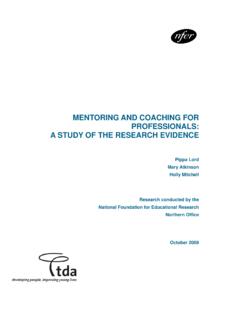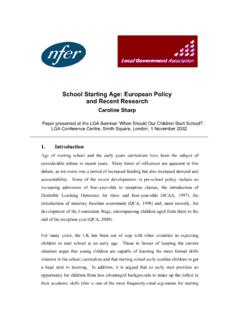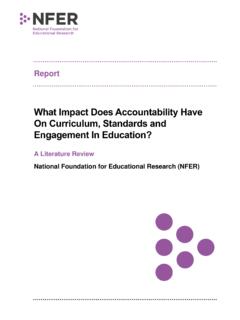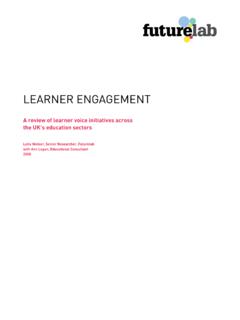Transcription of Maths Teacher Guide Year 3 Supplement - Autumn
1 Maths Teacher Guide year 3 Supplement Autumn 3 Autumn Supplement to Teacher Guide year 3. Maths nfer tests Maths year 3 NFER. Copyright details First published 2017. by the National Foundation for Educational Research, The Mere, Upton Park, Slough, Berkshire SL1 2DQ. National Foundation for Educational Research 2017. Registered Charity No. 313392. All rights reserved. No part of this document may be reproduced or transmitted in any form or by any means, electronic, mechanical, photocopying, or otherwise, without prior written permission of NFER, unless within the terms of licences issued by the Copyright Licensing Agency. To access the score converter and the question grid spreadsheets you will need to go to our secure School Portal on the NFER's website: and then enter your NFER Number: Project Number: Unique Password: (please write them in above for quick reference). The letter and despatch notes that accompanied the test materials are pre-populated with the details of the numbers and password.
2 If you have lost the letter and despatch notes, the portal website has links where you can request your details again. 2. NFER nfer tests Maths year 3. Using the outcomes of the test This section provides teachers with information to convert pupils' test scores into more useful measures of their attainment. If the year 3 mathematics test is undertaken and marked in line with the guidance in the Teacher Guide , then both a standardised score and an age standardised score can be derived from a pupil's test score . The starting point for both of these outcomes is to total a pupil's marks from the three mathematics booklets. This gives each pupil's total score or raw' score . A box is provided on the front cover of each test booklet to assist in this. In order to obtain reliable outcomes, you should administer the test according to the guidance given in this booklet. It is particularly important that you observe the time limits given in the test instructions, and mark questions strictly according to the mark scheme.
3 If not, the information derived from this section cannot be used reliably. If you wish to record and explore patterns of performance on the test across your whole class, you may find it helpful to complete a question grid. For each question, the question grid shows the average mark of pupils in the standardisation sample. It also shows which questions address each of the elements of the Programme of Study. Completing pupils' scores in the question grid will enable you to compare performance on different areas of the Programme of Study with a nationally representative sample. This is available from the following website, which will require online registration for access: 3. nfer tests Maths year 3 NFER. Standardised scores Standardised scores enable a comparison to be made between the performance of a pupil and that of other pupils who have taken the same test. Such comparisons can be useful for grouping your class by ability and for identifying those pupils in need of targeted interventions.
4 The average standardised score is set at 100, based on the performance of a nationally representative sample. About two-thirds of pupils will have standardised scores between 85 and 115 and scores within this range can be broadly described as 'average'. For example, a Teacher administered the test to her class. One pupil, Lucy, achieved a raw score of 32 on the test, giving her a standardised score of 103. The Teacher could then say that Lucy achieved an average score on the test. Almost all pupils fall within the range 70 to 140, so scores outside this range can be regarded as exceptional. These exceptional scores are marked with ** on the charts on page 5 as standardised scores cannot be calculated with the necessary statistical reliability. If an exact score is needed, for example to calculate an average score for the class, 69 or 141 should be used as appropriate for these pupils.
5 It is worth noting here that the scaled score of 100 defined by the Department for Education as the national expectation at the end of key stage 2 is not the same as, nor equivalent to, a standardised score of 100 on these tests. On these tests, a standardised score of 100 represents the average performance, based on a normal distribution, of the sample of pupils on which the tests were standardised. At the end of key stage 2 , the DfE's scaled score of 100 represents the expected standard' and is not the average. In order to save time and ensure accuracy, you can download a spreadsheet which will calculate each pupil's standardised score and age standardised score if you enter their date of birth and date of test. This spreadsheet is available from the following website: 4. NFER nfer tests Maths year 3. Standardised Standardised Standardised Raw score Raw score Raw score score score score 0 ** 31 103 62 124.
6 1 ** 32 103 63 125. 2 ** 33 104 64 126. 3 72 34 105 65 127. 4 75 35 105 66 128. 5 77 36 106 67 129. 6 78 37 107 68 131. 7 80 38 107 69 132. 8 81 39 108 70 134. 9 83 40 108 71 135. 10 84 41 109 72 137. 11 85 42 110 73 139. 12 87 43 110 74 **. 13 88 44 111 75 **. 14 89 45 111 76 **. 15 90 46 112 77 **. 16 91 47 112 78 **. 17 92 48 113 79 **. 18 93 49 114 80 **. 19 94 50 115. 20 95 51 115. 21 96 52 116. 22 97 53 117. 23 97 54 118. 24 98 55 118. 25 99 56 119. 26 100 57 120. 27 100 58 121. 28 101 59 121. 29 101 60 122. 30 102 61 123. 5. nfer tests Maths year 3 NFER. Confidence bands Confidence bands are used to show the extent of the margin of error in the standardised scores. In other words, they show how accurately the test measures pupils' ability in mathematics. The margin of error is simply a statistical estimate, based on the fact that tests can only sample the particular area of learning which they assess and that therefore the score a pupil achieves may vary within a few points of their true score '.
7 To indicate how wide this margin of error is likely to be, a 90 per cent confidence band' has been calculated. This means that you can have 90 per cent certainty that the true score lies within the confidence band. The table below gives the numbers that should be subtracted from and added to pupils' standardised scores at different score points to form the 90 per cent confidence bands. Standardised score range To form 90% confidence band: subtract add 72, 75, 77, 78, 80, 81, 83 85, 87 5 6. 88 112 5 5. 113 129, 131 6 5. 132, 134, 135, 137, 139 6 4. Take three pupils, Rachel, Nathan and David, with standardised scores of 101, 99 and 124 respectively. For Rachel, with a standardised score of 101 on this test, the 90 per cent confidence band is plus or minus 5. Therefore, you can be 90 per cent certain (there is a nine-out-of-ten chance) that Rachel's true score is between 96 and 106.
8 Both Nathan, who has a standardised score of 99, and Rachel are working at about the average for their age. Nathan's true score is between 94 and 104. However, David, with a standardised score of 124, achieved an above average score on the test and has a 90 per cent likelihood of having a true score between 118 and 129. For high and low scores, the confidence bands are asymmetrical (they tend to be pulled towards the average test score ). 6. NFER nfer tests Maths year 3. Age standardised scores Age standardised scores take into account a pupil's age in years and months at the time of sitting the test, in order that his or her performance can be compared with the performance of other pupils of the same age in a nationally representative sample. The age standardisation that has been undertaken means that these tests can be administered at different points in the school year and comparative information still be obtained.
9 The age standardised scores in this booklet cover the age range 7 years 0 months to 8 years 7 months. If you have decided to give the test to pupils outside this range, you will not be able to use the table. You will still, however, be able to calculate standardised scores. In order to save time and ensure accuracy, you can download a spreadsheet, which will calculate each pupil's standardised and age standardised score if you enter their date of birth and date of test, from: If you have not downloaded the spreadsheet, you should convert the total score into an age standardised score as follows: list the ages of all pupils in your class in years and completed months at the time of testing for each pupil, locate his or her age in years and months along the top of the table on pages 10 13. locate the pupil's total score down the left side of the table read off the age standardised score from where the row and column meet.
10 The average age standardised score is set at 100, based on the performance of a nationally representative sample. About two-thirds of pupils will have age standardised scores between 85. and 115 and scores within this range can broadly be described as average'. Almost all pupils fall within the range 70 to 140, so scores outside this range can be regarded as exceptional. These exceptional scores are marked with ** on the table on pages 10 13 as age standardised scores cannot be calculated with the necessary statistical reliability. If an exact score is needed, for example to calculate an average for the class, 69 or 141 should be used as appropriate for these pupils. As mentioned for standardised scores, the scaled score of 100 defined by the Department for Education as the national expectation at the end of key stage 2 is not the same as, nor equivalent to, an age standardised score of 100 on these tests.










